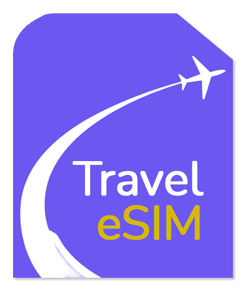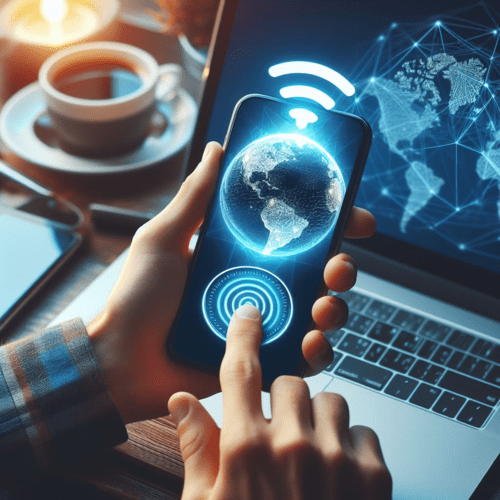What is a mobile hotspot?
A mobile hotspot (or personal hotspot), allows you to share your smartphone’s cellular data plan and internet connection with other devices like laptops or tablets.
There are three main types of mobile hotspots:
Wi-Fi Hotspot
When enabled, your phone broadcasts a wireless network that other devices can connect to, just like a regular Wi-Fi router and allows you to share your phone’s cellular data with other Wi-Fi-enabled devices in range.
Bluetooth Hotspot
Bluetooth tethering is generally slower and has a shorter range than Wi-Fi, but it can be useful in certain situations.
USB Hotspot
This allows the other device to access the internet through your phone’s cellular data connection. USB tethering is less common with modern devices, but it can still be a handy option.
How to Set Up a Hotspot: SIM and eSIM
Setting up a mobile hotspot is generally straightforward, here’s how to set it up on different platforms:
On iOS
- Go to Settings
- Personal Hotspot
- Toggle on “Allow Others to Join”
Go to your eSIM installation page to check if APN is required. In case the eSIM requires the APN to be manually set, you will need to do that for the hotspot APN as well as follows:
- Go to Settings on your device
- Go to Cellular/Mobile Data
- Go to your eSIM under Cellular/Mobile Data Plans
- Go to Cellular/Mobile Data Network
- In the Personal Hotspot APN field, type the APN as written in the eSIM installation details (all lower case, all one word)
- Leave Username and password blank
On Android
In order to turn on your device’s hotspot, please follow these steps:
- Set an APN before enabling Hotspot & tethering
- From the Home screen, head to Settings on your device(pull down the notification bar and hit the gear-shaped Settings button)
- Go to Network & Internet
- Tap “Hotspot & tethering.”
- Tap “Wi-Fi hotspot” and turn on “Wi-Fi hotspot.”
From Wi-Fi
To connect another device to your mobile hotspot over Wi-Fi, simply look for the broadcasted Wi-Fi network name (usually your phone’s name) from the other device and enter the password when prompted.
From Bluetooth
For Bluetooth tethering, the process varies by device but generally involves:
Enabling Bluetooth on both your phone and the other device
Making your phone’s Bluetooth “discoverable”
Pairing the devices and selecting the option to share your phone’s internet connection
With a USB Cable
If you prefer USB tethering, you’ll need to connect your phone to the other device with a USB cable. On most devices, this will automatically prompt you to allow/enable USB tethering.
No matter which method you choose, setting up a hotspot lets you easily share your phone’s cellular data with other devices, keeping them connected even when a Wi-Fi network isn’t available.
Why would you need a mobile hotspot when traveling?
With a mobile hotspot, you can easily get internet access for your laptop, tablet, or other devices wherever you have cellular coverage.
This means you can stay connected and productive even when you’re on the move, whether you’re in a car, train, or just exploring a new city.
Share Internet with Travel Companions
A mobile hotspot allows you to share your internet connection with everyone in the group. This can be more convenient and cost-effective than having everyone purchase their own separate data plan.
Avoid Unreliable Public Wi-Fi
Public Wi-Fi networks at hotels, airports, or cafes can be slow, and provide a security risk but with your own private hotspot, you can sidestep these hassles altogether.
Access Online Maps and Translation Apps
I remember when I got lost in Rome, it would’ve been great to have access to the internet so I could pull up a map and get us back in the right direction faster (and avoid getting lost in the first place!) by being connected wherever you are you will know exactly where you are.
Stream Entertainment on Long Journeys
During long train or road trips, a hotspot can keep you and your friends entertained by allowing you to stream movies, shows, or music on your devices without relying on in-flight or in-car Wi-Fi.
When should I set up my eSIM?
The best time to activate and set up your travel eSIM is before you leave.
That way you will have an internet connection as soon as you land in your travel destination.
Using eSIMs when traveling
eSIMs can be incredibly useful for staying connected while travelling, offering a convenient alternative to traditional physical SIM cards. Here are some advantages and tips for using eSIMs on your trips:
Advantages of eSIMs for Travelers
No need to physically swap SIM cards: With an eSIM, you can easily switch between data plans or carriers without having to remove and insert different SIM cards.
Avoid roaming fees: Many eSIM providers offer attractively priced data plans for international roaming, helping you avoid expensive roaming charges from your regular carrier.
Instant activation: eSIMs can often be activated and ready to use within minutes, giving you immediate access to data when you arrive at your destination.
Tips for Using eSIMs While Traveling
Enable data roaming: Remember to turn on data roaming for your eSIM plan, as it’s usually disabled by default to prevent accidental charges.
Monitor data usage: Keep an eye on your data consumption, especially if your eSIM plan has a limited allowance. Many providers offer tools to track and manage your usage.
Research coverage areas: Before your trip, check which countries and regions are covered by your eSIM provider’s network to ensure you’ll have service where you’re going.
Have a backup plan: While eSIMs are convenient, it’s still a good idea to have a backup option, such as a portable Wi-Fi hotspot or a physical SIM card, in case you encounter any issues with your eSIM service.
By taking advantage of eSIMs, you can enjoy the freedom and flexibility of staying connected without the hassle of dealing with physical SIM cards or worrying about excessive roaming charges. Just remember to plan ahead and manage your data usage wisely.
Tips on using mobile hotspot
While mobile hotspots are incredibly convenient, there are a few things to keep in mind to ensure a smooth and efficient experience. Here are some tips for using your phone’s hotspot effectively:
Battery Life Considerations
Running a mobile hotspot can drain your phone’s battery faster than usual, as it’s using more power to broadcast the Wi-Fi network and share your internet connection. To conserve battery life:
Disable the hotspot when you’re not actively using it
Lower the hotspot’s signal strength or range to reduce power consumption
Use battery-saving modes or features on your phone
Security Precautions
It’s important to secure your mobile hotspot to prevent unauthorized access and protect your data. Here are some security best practices:
Set a strong, unique password for your hotspot
Avoid using your hotspot on unsecured public networks
Keep your phone’s software and security apps up-to-date
Data Usage Management
Using your phone’s cellular data as a hotspot can consume a lot of data, potentially leading to overage charges or throttled speeds. To manage your data usage:
Monitor your data consumption regularly using your carrier’s app or built-in tools
Set data limits or warnings to avoid unexpected overages
Connect to Wi-Fi networks whenever possible to reduce cellular data usage
Other Tips and Tricks
For the best performance, position your phone in an area with a strong cellular signal
Limit the number of connected devices to ensure a stable connection for all users
If possible, use the 5GHz Wi-Fi band for faster speeds and less interference


